University Report: Analysis of CAUTI and Strategies for Reduction
VerifiedAdded on 2022/07/28
|6
|1189
|25
Report
AI Summary
This report examines catheter-associated urinary tract infections (CAUTI), a significant issue in hospital settings. It analyzes two articles focusing on CAUTI reduction strategies, considering the PICO question framework. The first article highlights the impact of indwelling catheters in critical care units and the importance of evidence-based practice. The second article discusses the effectiveness of restricting catheter insertion in emergency departments, as demonstrated by the "Foley Free ED" program. Both articles emphasize the role of awareness and proper management in reducing CAUTI rates. The report concludes that awareness development is crucial for CAUTI reduction, supporting evidence-based practices to identify the most effective strategies. The analysis includes a discussion on the relevance of the articles and their contribution to addressing the research question, highlighting the significance of the findings for healthcare professionals.
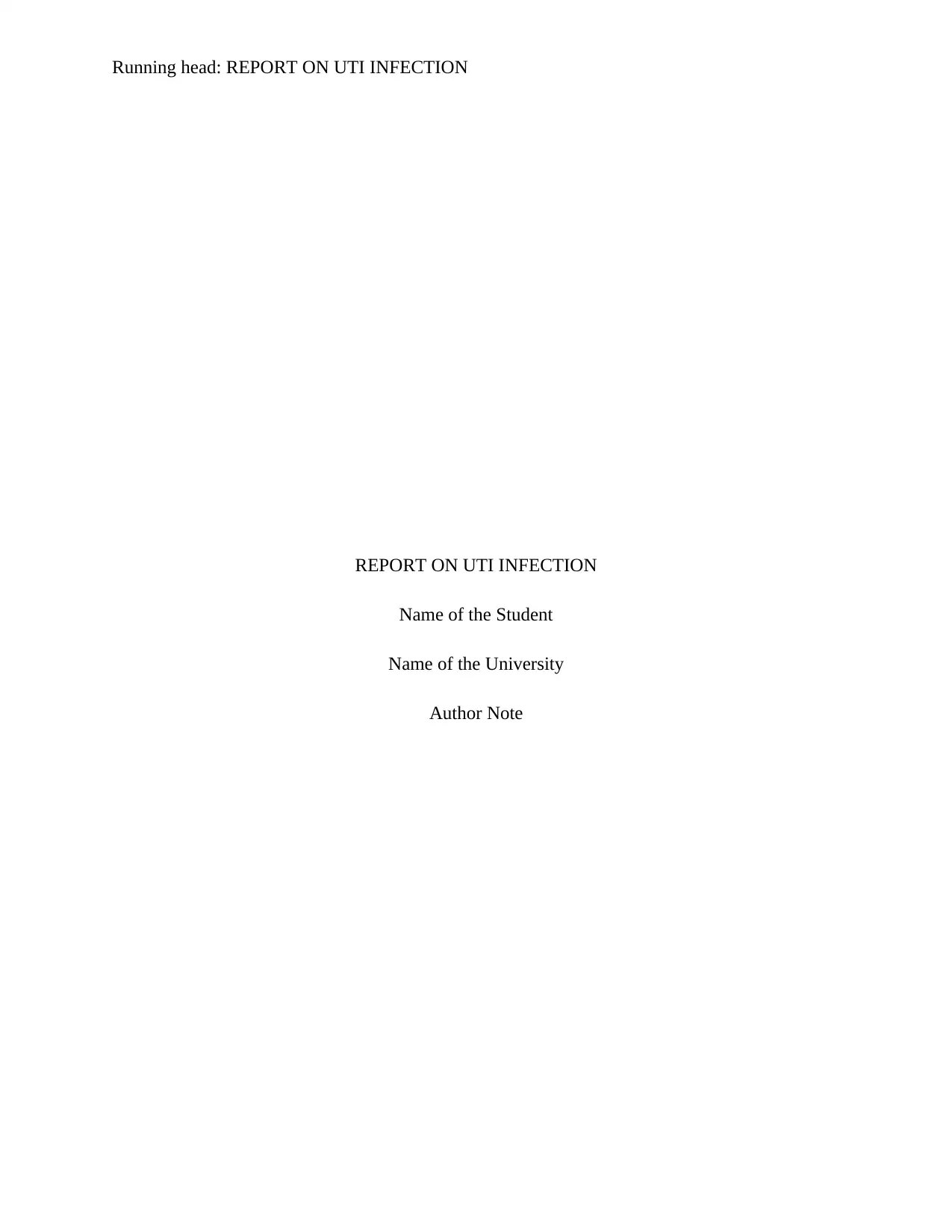
Running head: REPORT ON UTI INFECTION
REPORT ON UTI INFECTION
Name of the Student
Name of the University
Author Note
REPORT ON UTI INFECTION
Name of the Student
Name of the University
Author Note
Paraphrase This Document
Need a fresh take? Get an instant paraphrase of this document with our AI Paraphraser
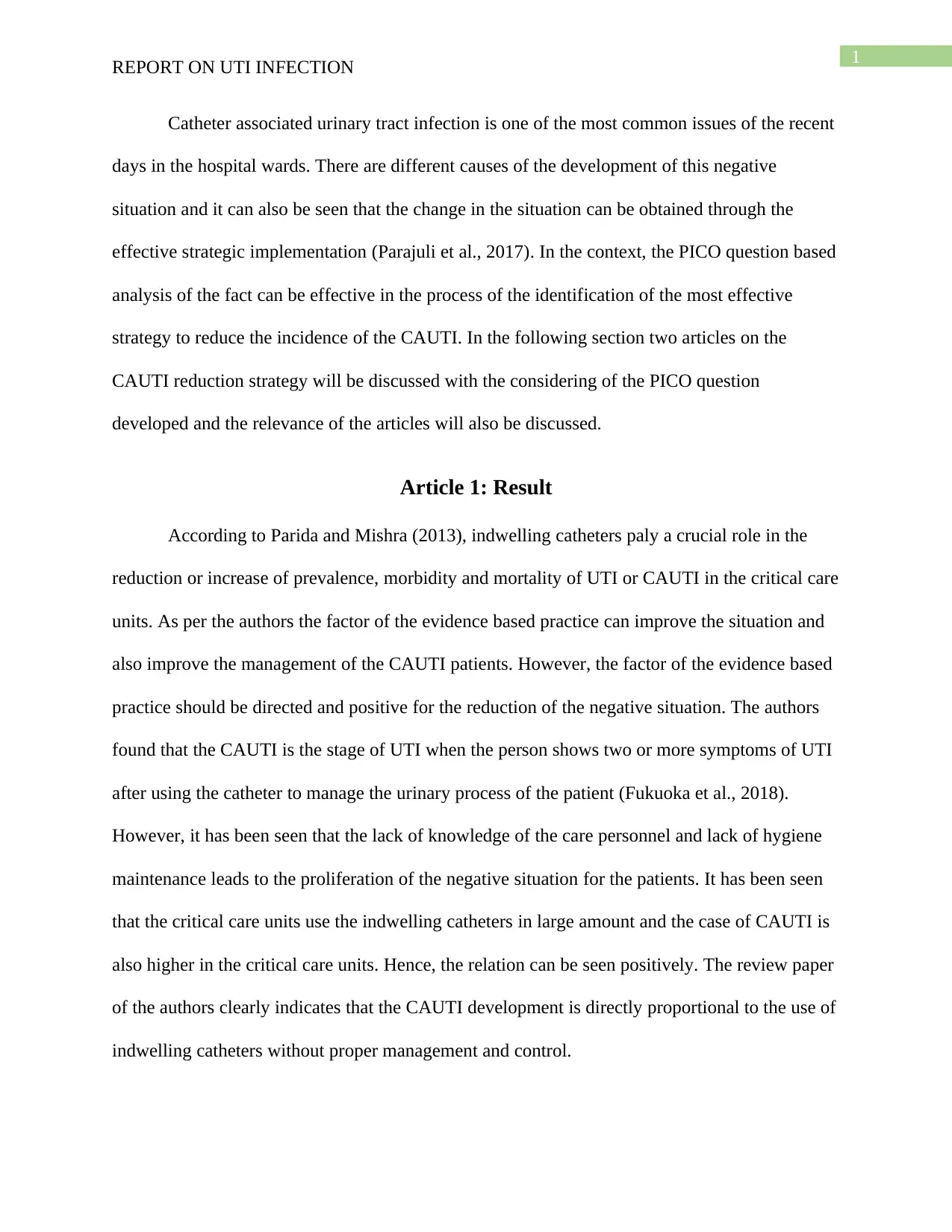
1
REPORT ON UTI INFECTION
Catheter associated urinary tract infection is one of the most common issues of the recent
days in the hospital wards. There are different causes of the development of this negative
situation and it can also be seen that the change in the situation can be obtained through the
effective strategic implementation (Parajuli et al., 2017). In the context, the PICO question based
analysis of the fact can be effective in the process of the identification of the most effective
strategy to reduce the incidence of the CAUTI. In the following section two articles on the
CAUTI reduction strategy will be discussed with the considering of the PICO question
developed and the relevance of the articles will also be discussed.
Article 1: Result
According to Parida and Mishra (2013), indwelling catheters paly a crucial role in the
reduction or increase of prevalence, morbidity and mortality of UTI or CAUTI in the critical care
units. As per the authors the factor of the evidence based practice can improve the situation and
also improve the management of the CAUTI patients. However, the factor of the evidence based
practice should be directed and positive for the reduction of the negative situation. The authors
found that the CAUTI is the stage of UTI when the person shows two or more symptoms of UTI
after using the catheter to manage the urinary process of the patient (Fukuoka et al., 2018).
However, it has been seen that the lack of knowledge of the care personnel and lack of hygiene
maintenance leads to the proliferation of the negative situation for the patients. It has been seen
that the critical care units use the indwelling catheters in large amount and the case of CAUTI is
also higher in the critical care units. Hence, the relation can be seen positively. The review paper
of the authors clearly indicates that the CAUTI development is directly proportional to the use of
indwelling catheters without proper management and control.
REPORT ON UTI INFECTION
Catheter associated urinary tract infection is one of the most common issues of the recent
days in the hospital wards. There are different causes of the development of this negative
situation and it can also be seen that the change in the situation can be obtained through the
effective strategic implementation (Parajuli et al., 2017). In the context, the PICO question based
analysis of the fact can be effective in the process of the identification of the most effective
strategy to reduce the incidence of the CAUTI. In the following section two articles on the
CAUTI reduction strategy will be discussed with the considering of the PICO question
developed and the relevance of the articles will also be discussed.
Article 1: Result
According to Parida and Mishra (2013), indwelling catheters paly a crucial role in the
reduction or increase of prevalence, morbidity and mortality of UTI or CAUTI in the critical care
units. As per the authors the factor of the evidence based practice can improve the situation and
also improve the management of the CAUTI patients. However, the factor of the evidence based
practice should be directed and positive for the reduction of the negative situation. The authors
found that the CAUTI is the stage of UTI when the person shows two or more symptoms of UTI
after using the catheter to manage the urinary process of the patient (Fukuoka et al., 2018).
However, it has been seen that the lack of knowledge of the care personnel and lack of hygiene
maintenance leads to the proliferation of the negative situation for the patients. It has been seen
that the critical care units use the indwelling catheters in large amount and the case of CAUTI is
also higher in the critical care units. Hence, the relation can be seen positively. The review paper
of the authors clearly indicates that the CAUTI development is directly proportional to the use of
indwelling catheters without proper management and control.
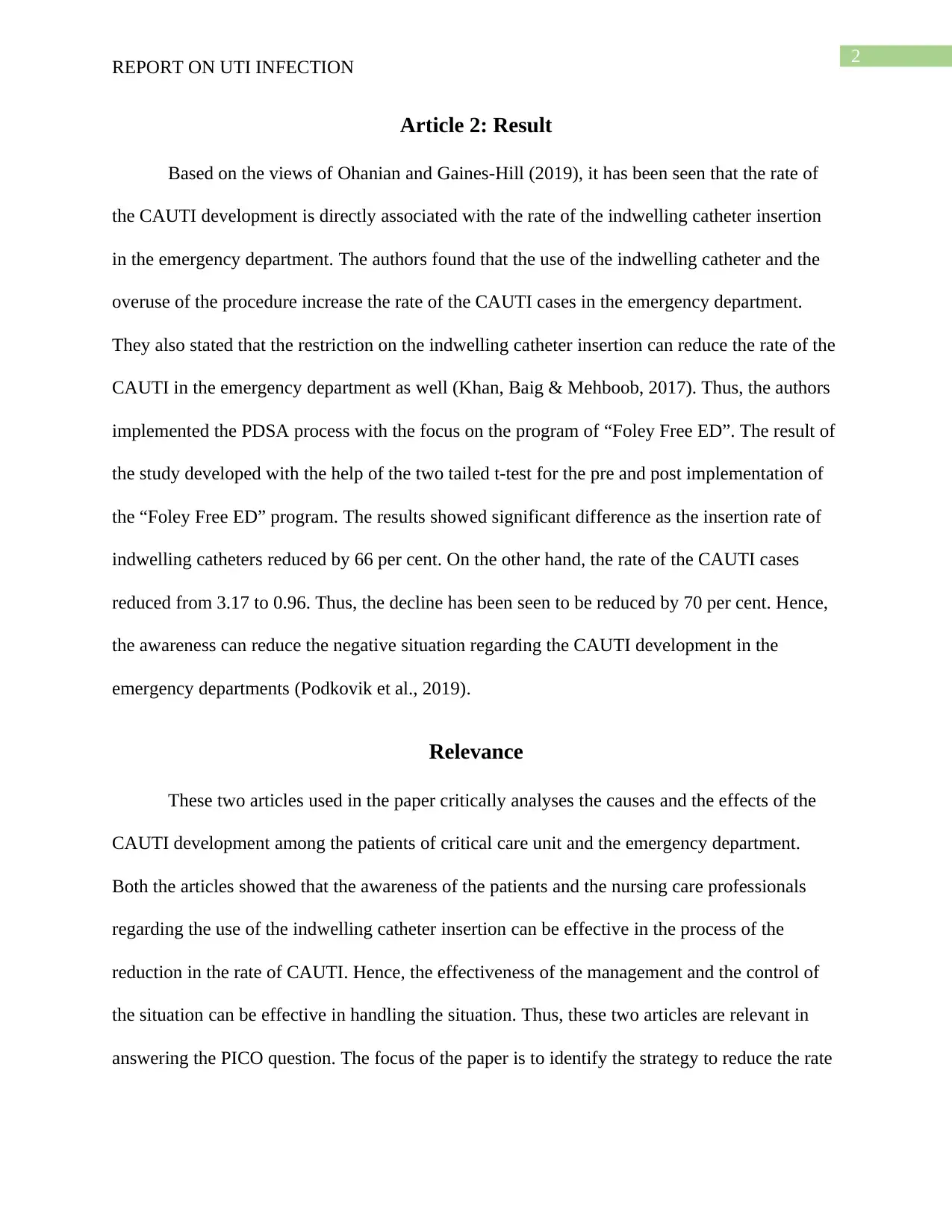
2
REPORT ON UTI INFECTION
Article 2: Result
Based on the views of Ohanian and Gaines-Hill (2019), it has been seen that the rate of
the CAUTI development is directly associated with the rate of the indwelling catheter insertion
in the emergency department. The authors found that the use of the indwelling catheter and the
overuse of the procedure increase the rate of the CAUTI cases in the emergency department.
They also stated that the restriction on the indwelling catheter insertion can reduce the rate of the
CAUTI in the emergency department as well (Khan, Baig & Mehboob, 2017). Thus, the authors
implemented the PDSA process with the focus on the program of “Foley Free ED”. The result of
the study developed with the help of the two tailed t-test for the pre and post implementation of
the “Foley Free ED” program. The results showed significant difference as the insertion rate of
indwelling catheters reduced by 66 per cent. On the other hand, the rate of the CAUTI cases
reduced from 3.17 to 0.96. Thus, the decline has been seen to be reduced by 70 per cent. Hence,
the awareness can reduce the negative situation regarding the CAUTI development in the
emergency departments (Podkovik et al., 2019).
Relevance
These two articles used in the paper critically analyses the causes and the effects of the
CAUTI development among the patients of critical care unit and the emergency department.
Both the articles showed that the awareness of the patients and the nursing care professionals
regarding the use of the indwelling catheter insertion can be effective in the process of the
reduction in the rate of CAUTI. Hence, the effectiveness of the management and the control of
the situation can be effective in handling the situation. Thus, these two articles are relevant in
answering the PICO question. The focus of the paper is to identify the strategy to reduce the rate
REPORT ON UTI INFECTION
Article 2: Result
Based on the views of Ohanian and Gaines-Hill (2019), it has been seen that the rate of
the CAUTI development is directly associated with the rate of the indwelling catheter insertion
in the emergency department. The authors found that the use of the indwelling catheter and the
overuse of the procedure increase the rate of the CAUTI cases in the emergency department.
They also stated that the restriction on the indwelling catheter insertion can reduce the rate of the
CAUTI in the emergency department as well (Khan, Baig & Mehboob, 2017). Thus, the authors
implemented the PDSA process with the focus on the program of “Foley Free ED”. The result of
the study developed with the help of the two tailed t-test for the pre and post implementation of
the “Foley Free ED” program. The results showed significant difference as the insertion rate of
indwelling catheters reduced by 66 per cent. On the other hand, the rate of the CAUTI cases
reduced from 3.17 to 0.96. Thus, the decline has been seen to be reduced by 70 per cent. Hence,
the awareness can reduce the negative situation regarding the CAUTI development in the
emergency departments (Podkovik et al., 2019).
Relevance
These two articles used in the paper critically analyses the causes and the effects of the
CAUTI development among the patients of critical care unit and the emergency department.
Both the articles showed that the awareness of the patients and the nursing care professionals
regarding the use of the indwelling catheter insertion can be effective in the process of the
reduction in the rate of CAUTI. Hence, the effectiveness of the management and the control of
the situation can be effective in handling the situation. Thus, these two articles are relevant in
answering the PICO question. The focus of the paper is to identify the strategy to reduce the rate
⊘ This is a preview!⊘
Do you want full access?
Subscribe today to unlock all pages.

Trusted by 1+ million students worldwide
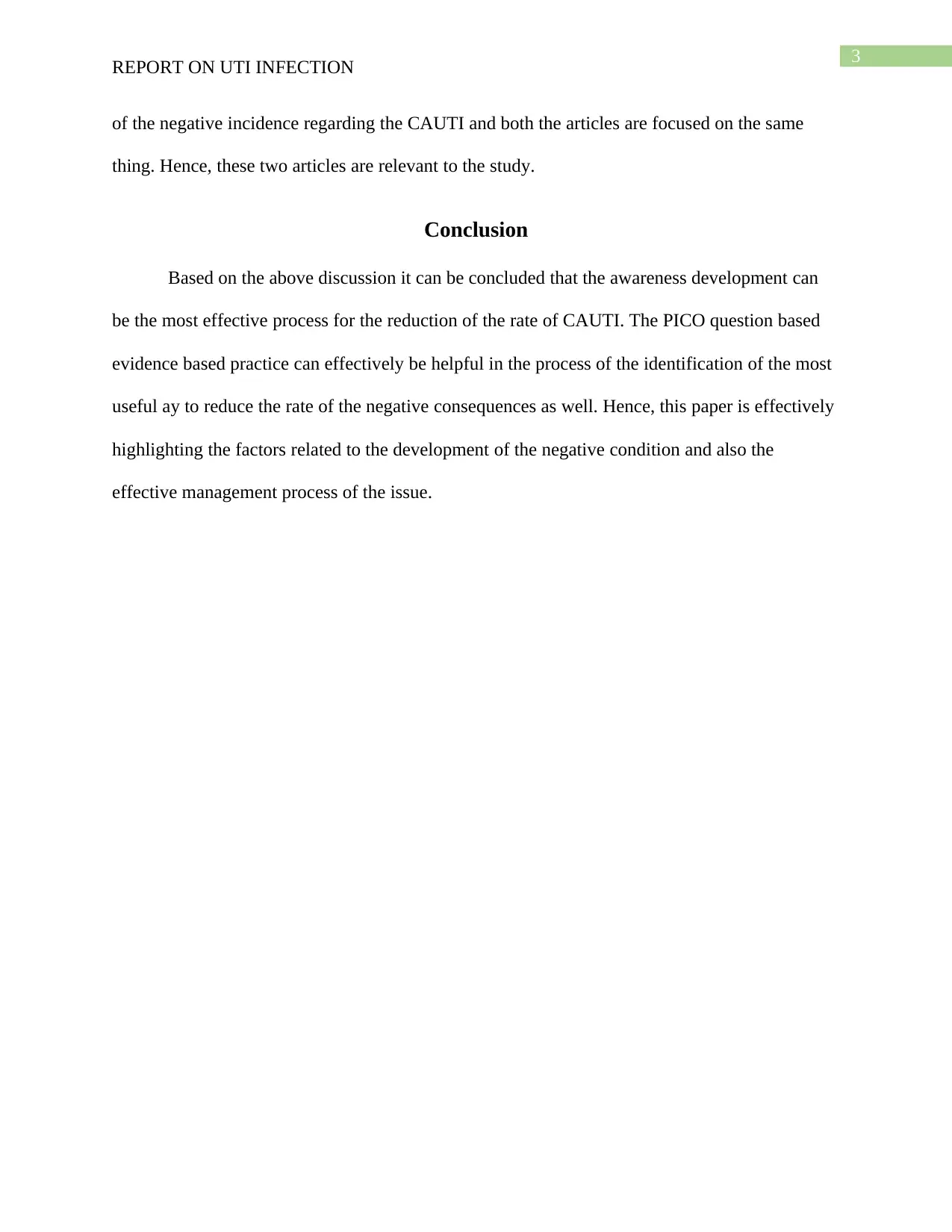
3
REPORT ON UTI INFECTION
of the negative incidence regarding the CAUTI and both the articles are focused on the same
thing. Hence, these two articles are relevant to the study.
Conclusion
Based on the above discussion it can be concluded that the awareness development can
be the most effective process for the reduction of the rate of CAUTI. The PICO question based
evidence based practice can effectively be helpful in the process of the identification of the most
useful ay to reduce the rate of the negative consequences as well. Hence, this paper is effectively
highlighting the factors related to the development of the negative condition and also the
effective management process of the issue.
REPORT ON UTI INFECTION
of the negative incidence regarding the CAUTI and both the articles are focused on the same
thing. Hence, these two articles are relevant to the study.
Conclusion
Based on the above discussion it can be concluded that the awareness development can
be the most effective process for the reduction of the rate of CAUTI. The PICO question based
evidence based practice can effectively be helpful in the process of the identification of the most
useful ay to reduce the rate of the negative consequences as well. Hence, this paper is effectively
highlighting the factors related to the development of the negative condition and also the
effective management process of the issue.
Paraphrase This Document
Need a fresh take? Get an instant paraphrase of this document with our AI Paraphraser
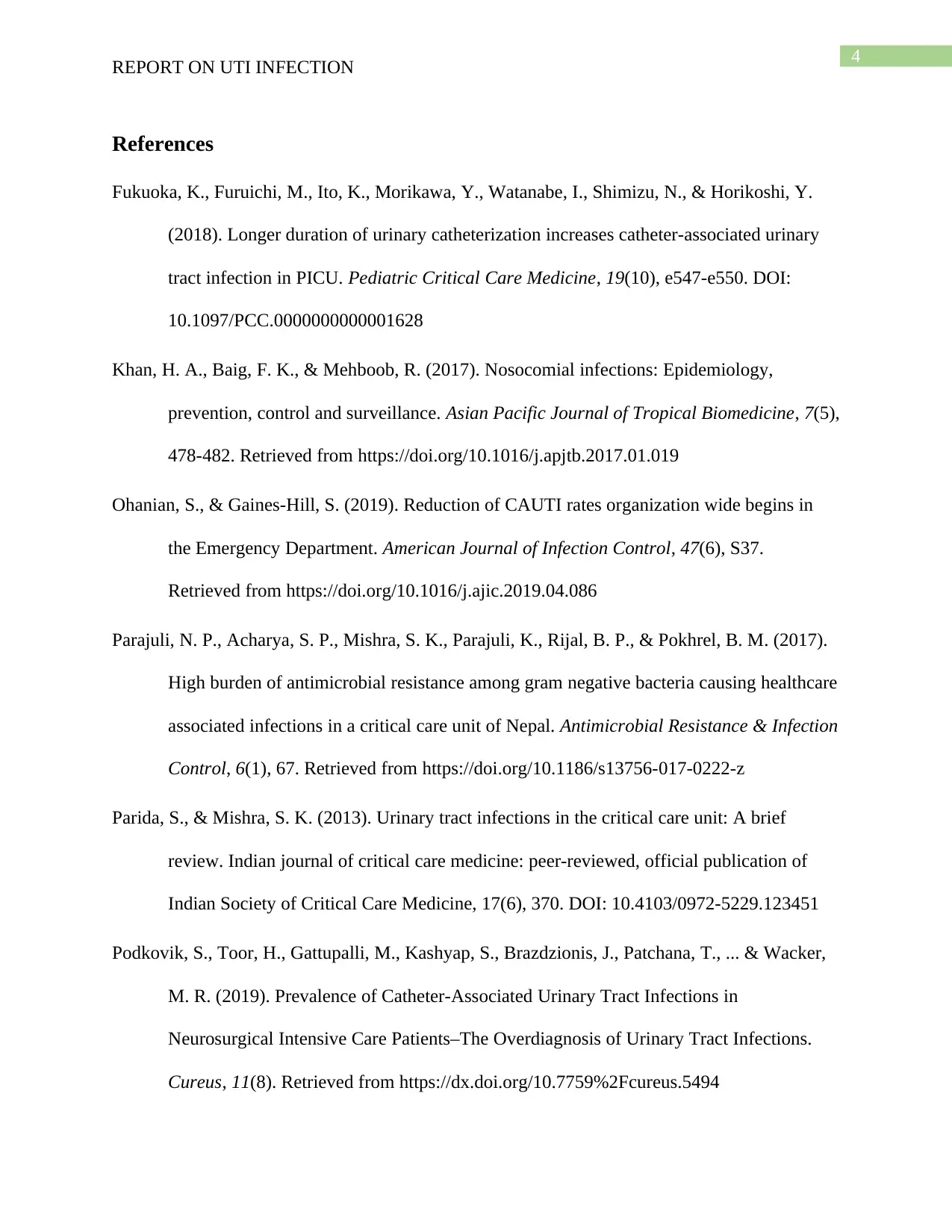
4
REPORT ON UTI INFECTION
References
Fukuoka, K., Furuichi, M., Ito, K., Morikawa, Y., Watanabe, I., Shimizu, N., & Horikoshi, Y.
(2018). Longer duration of urinary catheterization increases catheter-associated urinary
tract infection in PICU. Pediatric Critical Care Medicine, 19(10), e547-e550. DOI:
10.1097/PCC.0000000000001628
Khan, H. A., Baig, F. K., & Mehboob, R. (2017). Nosocomial infections: Epidemiology,
prevention, control and surveillance. Asian Pacific Journal of Tropical Biomedicine, 7(5),
478-482. Retrieved from https://doi.org/10.1016/j.apjtb.2017.01.019
Ohanian, S., & Gaines-Hill, S. (2019). Reduction of CAUTI rates organization wide begins in
the Emergency Department. American Journal of Infection Control, 47(6), S37.
Retrieved from https://doi.org/10.1016/j.ajic.2019.04.086
Parajuli, N. P., Acharya, S. P., Mishra, S. K., Parajuli, K., Rijal, B. P., & Pokhrel, B. M. (2017).
High burden of antimicrobial resistance among gram negative bacteria causing healthcare
associated infections in a critical care unit of Nepal. Antimicrobial Resistance & Infection
Control, 6(1), 67. Retrieved from https://doi.org/10.1186/s13756-017-0222-z
Parida, S., & Mishra, S. K. (2013). Urinary tract infections in the critical care unit: A brief
review. Indian journal of critical care medicine: peer-reviewed, official publication of
Indian Society of Critical Care Medicine, 17(6), 370. DOI: 10.4103/0972-5229.123451
Podkovik, S., Toor, H., Gattupalli, M., Kashyap, S., Brazdzionis, J., Patchana, T., ... & Wacker,
M. R. (2019). Prevalence of Catheter-Associated Urinary Tract Infections in
Neurosurgical Intensive Care Patients–The Overdiagnosis of Urinary Tract Infections.
Cureus, 11(8). Retrieved from https://dx.doi.org/10.7759%2Fcureus.5494
REPORT ON UTI INFECTION
References
Fukuoka, K., Furuichi, M., Ito, K., Morikawa, Y., Watanabe, I., Shimizu, N., & Horikoshi, Y.
(2018). Longer duration of urinary catheterization increases catheter-associated urinary
tract infection in PICU. Pediatric Critical Care Medicine, 19(10), e547-e550. DOI:
10.1097/PCC.0000000000001628
Khan, H. A., Baig, F. K., & Mehboob, R. (2017). Nosocomial infections: Epidemiology,
prevention, control and surveillance. Asian Pacific Journal of Tropical Biomedicine, 7(5),
478-482. Retrieved from https://doi.org/10.1016/j.apjtb.2017.01.019
Ohanian, S., & Gaines-Hill, S. (2019). Reduction of CAUTI rates organization wide begins in
the Emergency Department. American Journal of Infection Control, 47(6), S37.
Retrieved from https://doi.org/10.1016/j.ajic.2019.04.086
Parajuli, N. P., Acharya, S. P., Mishra, S. K., Parajuli, K., Rijal, B. P., & Pokhrel, B. M. (2017).
High burden of antimicrobial resistance among gram negative bacteria causing healthcare
associated infections in a critical care unit of Nepal. Antimicrobial Resistance & Infection
Control, 6(1), 67. Retrieved from https://doi.org/10.1186/s13756-017-0222-z
Parida, S., & Mishra, S. K. (2013). Urinary tract infections in the critical care unit: A brief
review. Indian journal of critical care medicine: peer-reviewed, official publication of
Indian Society of Critical Care Medicine, 17(6), 370. DOI: 10.4103/0972-5229.123451
Podkovik, S., Toor, H., Gattupalli, M., Kashyap, S., Brazdzionis, J., Patchana, T., ... & Wacker,
M. R. (2019). Prevalence of Catheter-Associated Urinary Tract Infections in
Neurosurgical Intensive Care Patients–The Overdiagnosis of Urinary Tract Infections.
Cureus, 11(8). Retrieved from https://dx.doi.org/10.7759%2Fcureus.5494

5
REPORT ON UTI INFECTION
REPORT ON UTI INFECTION
⊘ This is a preview!⊘
Do you want full access?
Subscribe today to unlock all pages.

Trusted by 1+ million students worldwide
1 out of 6
Related Documents
Your All-in-One AI-Powered Toolkit for Academic Success.
+13062052269
info@desklib.com
Available 24*7 on WhatsApp / Email
![[object Object]](/_next/static/media/star-bottom.7253800d.svg)
Unlock your academic potential
Copyright © 2020–2025 A2Z Services. All Rights Reserved. Developed and managed by ZUCOL.





